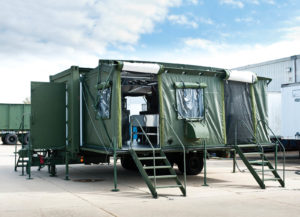
For several years the U.S. military market has been characterized by base closures and troop drawdowns, which has had an admittedly dampening effect on the need for and spending on military textiles. The United States isn’t the only geographic market for these products, nor are these textiles limited to just our military; purchasers are found around the globe, virtually anywhere there’s a fighting force requiring equipment, shelter and apparel. And although military expenditures in some of those areas declined prior to 2015, after that year spending began to rise, accompanied by predictions of additional increases for 2017 and beyond. Still, this isn’t a universal recovery, with some countries signaling that spending on military textiles is still decreasing or, at the least, remaining flat.
A similarly mixed picture is provided by U.S. manufacturers of these products. Mary Phelan, program manager, government and defense, for Polo Custom Products, describes the military market in general as “gradually ramping up.” Located in Topeka, Kan., the company supplies a variety of specialized products to the government.
“There is a great need to close existing gaps and upgrade troop and military readiness,” says Phelan. “The key will be the prioritization of those initiatives with the limited amount of funding available in the federal budget. There is catching up to do, and that doesn’t come overnight.”
It does appear that budgets affecting military textile suppliers are becoming more generous. According to Tim Offray, business development manager for OTEX Specialty Narrow Fabrics®, a Bernardsville, N.J., manufacturer of high-performance narrow textiles designed for mission-critical situations, the 2017 DLA (Defense Logistics Agency) forecast for clothing and textiles was $1.83 billion. This is an increase over 2015 and 2016, where the budget for both years was $1.7 billion. Still, there are trade-offs.
“The budget increase is definitely positive,” Offray says. “But the military continues to look for cost savings from their supply chain. Suppliers are carefully looking internally to reduce manufacturing costs, improve processes and efficiencies.”
There is also optimism from some manufacturers over the Trump presidency, since he made his intention to seek a sizable increase in military spending clear from the start. Although the extent of Congressional support has yet to be revealed, there is reason for encouragement.
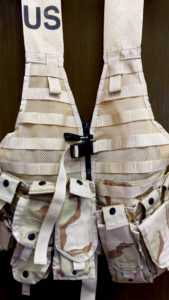
Put Jonathan Kurz, owner and CEO of Apex Mills, in that camp. Although he has witnessed a several-years decline in military spending, Kurz says this deflation seems to have halted and has steadied. And he anticipates that next year, military spending will rise, potentially juiced by the situation in North Korea, troop deployment to Afghanistan, and the possibility of additional deployments to, or heightened activity in areas like Iraq and Syria. In the meantime, demand for military textiles is coming from state police forces and the armed forces in other countries, says Kurz, whose Inwood, N.Y., company conceptualizes, designs and manufactures high-performance engineered textile solutions for an array of industries.
Joe Fields, vice president of business development for Outdoor Venture Corporation (OVC), is a little less upbeat about the military market—so far. Headquartered in Stearns, Ky., OVC manufactures a range of hard-wall and soft-wall shelter systems, including Mil-Spec tents and other tent-related items such as floors, liners and base-camp solutions. Some of the hard-wall shelters incorporate the company’s iPanel®, a galvanized steel skin with a polyurethane foam core that’s used to construct walls, floors and roofs. OVC is a prime Department of Defense (DoD) contractor, providing expeditionary military shelter systems (frame-supported, pole-supported and air-supported).
Fields says they’ve seen fewer buys so far this year compared to previous years, although they are noticing some small purchases for tent components.
“Unlike food and ammunition, tents aren’t required items on the equipment list; they’re much lower on the needs list,” he explains. “So, we’re seeing very little impact on the products we produce for the U.S. military. But, export opportunities do exist for foreign military sales.”
Budget cuts have greatly affected OVC’s business, says Fields. Still, with the unrest in the world and Trump’s refocusing on the military, the picture could brighten, although there’s an additional worry. Fabrics used in all U.S. military shelters must be produced using U.S.-made components (Berry compliant). However, there’s currently a shortage of polyester yarns—“The backbone of our industry,” says Fields—because the yarn manufacturer, DuraFiber, has closed its operations in the U.S., sending DoD tent manufacturers on the hunt for Berry-compliant fibers.
Manufacturer snapshots
Like Fields, Liz Johnson, director of business development for MMI Textiles Inc., looks positively on Trump’s presidency and its potential for accelerating the demand for textile products, while cautioning, however, that this depends on when contracts are released and what kinds of products
will be requested.
Located in Westlake, Ohio, MMI provides a diverse array of textile materials to various markets, striving to be a one-stop shop for its customers, says Johnson. The company supplies woven and knit fabrics, hardware, hook and loop, webbing and tape, zippers, labels and more to those making military apparel and gear.
“Nylon woven is still our number one selling material, which is the tried-and-true fabric of choice for individual equipment, including packs, armor carriers and other gear, as it has good strength and abrasion properties,” says Johnson.
MMI’s latest offering is a Berry-compliant line of performance knit apparel fabrics constructed from various fiber blends like polyester, Lycra®, modacrylic and FR (flame-resistant) rayon. The knits, with antimicrobial and wicking properties, include flame-resistant selections with weights ranging from next-to-skin layers to fleece material.
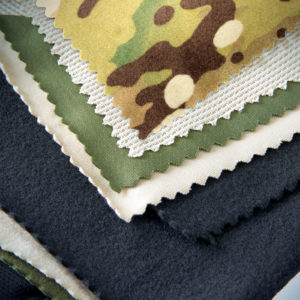
Apex supplies Berry-compliant, Mil-Spec textiles utilizing high-tenacity nylon, polyester and aramid fibers for enhanced strength and performance, says Kurz. Many are constructed with the company’s DryRUN™ family of fabrics, which provide embedded and/or topical moisture-management and antimicrobial properties. Military applications for Apex fabrics include mesh used in modular lightweight load-carrying equipment (MOLLE) and improved outer tactical vests (IOTVs), helmet linings, aircraft and combat vehicle seats; a 3-D spacer fabric used for the inside lining of armor plate vests that provides ventilation and shock absorption; fabrics used for tent screening and mosquito netting, and others. The company’s products are also used by police forces
and paramilitary organizations.
OTEX manufactures Mil-Spec and other high-performance FR webbing, tapes, cords and ropes to the military. Among the company’s “core competencies” is the ability to weave specialty branded yarns, such as Nomex®, Kevlar®, Vectran® and OTEX’s own Sentry FR® “No Melt, No Drip” elastics (among others), says Offray.
“The military has expressed increased interest in the application of flame-resistant materials; specifically, inherently FR materials including those with stretch capabilities that can be in direct skin contact and provide increased protection in intense heat and flame exposure,” says Offray, adding that the Sentry FR elastic collection offers a “heat degradation resistance over 20 times improvement than regular elastics.” These elastics are used for undergarments, goggle straps, stretch drawstrings, suspenders and various other straps.
Among the more specialized products Polo supplies to the military are those using high-performing chemical- and agent-resistant materials, such as the Chemical Protective Patient Wrap (CPPW), says Jennifer Fennell, sourcing manager for the company.
“We designed this in partnership with the U.S. Army prior to Desert Storm,” Fennell says. “Our CPPW uses the same kind of filter material used in CBRN [chemical, biological, radioactive and nuclear] suits. We’re still producing this product today, but with even more complex carbon-impregnated materials.”
The company also manufactures an Enhanced Parachutist Drop Bag incorporating 14 different webbings and specialized buckles, as well as an array of customized bags, cases and covers for military equipment and specific applications.
Call for performance

Fennell says there’s demand for CBRN and ballistic protection, along with the desire for lightweight and resistant materials and those having other protective qualities.
“We also see a demand from commercial products used in the fire and safety industries, such as nylon heat-resistant products,” she adds. “The military is starting to use these materials due to the attractiveness of the high melting point in a nylon product and the reduced weight compared to metal hardware.”
As for mesh, it still remains a staple for the military, says Kurz; however, there’s growing interest in the company’s 3-D spacer fabrics. These three-layer fabrics have a top and bottom layer that can be a mesh, a solid knit or a combination of both, coupled with an inside layer of connecting monofilament fiber, which adds thickness and resiliency. They’re used for soft body armor, backpack panels and straps, providing additional comfort.
“Comfort features are important to military products, as are moisture properties such as wicking and absorption, as well as fabric containing antimicrobial finishes,” says Kurz. “Moisture repellency is another treatment used to keep a fabric dry in moist environments. Still other textiles are constructed to reduce IR [infrared] signature and enhance stealth capabilities.”
Along with lighter-weight fabrics offering improved performance, requests for smart fabrics—such as those providing temperature control or incorporating conductivity features—are on the upswing, says Johnson.
Offray also notes the demand for integrated textile systems; for example, those incorporating technology allowing for wearable and mobile attachments on a combat vest, affording the ability to connect to and power data technology like GPS, battery packs and phones. “There is a significant focus on soldier load and system integration that can reduce the weight for war fighters and emergency responders while enhancing performance, protection and survivability,” he notes.
Other textile features Offray mentions as desired by the military include:
-
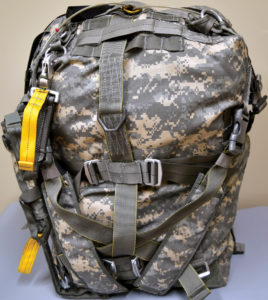
In addition to supplying a variety of specialized products to the government such as those with high-performing chemical- and agent-resistant materials, Polo Custom Products also manufactures the Enhanced Parachutist Drop Bag, shown here. The bag incorporates 14 different types of webbings as well as specialized buckles. Photo: Polo Custom Products. low-cost FR fabrics and narrow components
- multi-climate fabrics offering protection in extreme environments
- chemical and fuel protection for personal protective equipment
- lightweight components for torso and extremity protection
- advanced ballistic and blast fabrics and materials.
- Phelan says they’re noticing that contracting officers are taking a different perspective when it comes to their
supply chains.
“They’re interested in and open to suggestions for new materials, products and technologies,” she explains. “They are more progressive now than ever in understanding solutions and managing the supply chain. We’re optimistic about the future of the military market. Although some of the situations creating the need for new products are not desirable, in reality, this does create opportunities and the chance to be proactive and offer solutions.”
Pamela Mills-Senn is a freelance writer based in Long Beach, Calif.
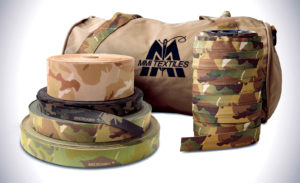
The U.S. Army’s Natick Soldier Research, Development and Engineering Center (NSRDEC), located in Natick, Mass., has a fairly exhaustive list of responsibilities. According to Carole Winterhalter, textile technologist, this includes clothing, individual equipment, personnel and cargo air drop, shelters and supporting sciences.
“[We] possess the requisite technical, engineering and acquisition personnel, laboratories, specialized equipment and knowledge to support the development and fielding of items and systems made primarily of fibers and textiles,” Winterhalter says.
She’s well-acquainted with the Army’s “perennial wish list” when it comes to textiles and related products, such as a desire for lighter-weight body armor, lightweight and breathable chem/bio protection and low-cost, domestically produced flame protection. Still, in case it appears that soldiers are doing without, Winterhalter emphasizes that today’s soldiers are “better equipped and protected than at any time in history.” Even so, it’s clear to the R&D organization there’s a demand for innovative fiber solutions.
“We need new high-strength-to-weight fibers for a variety of applications; not just for ballistics, but for stronger, lighter-weight uniforms, equipment, shelters and parachutes,” she says. “New fibers in general are needed that combine multiple performance characteristics for multifunctional textiles and equipment.
“Wouldn’t it be great,” Winterhalter adds, “if we could build new, lighter-weight equipment that was stronger, antimicrobial, camouflage printable and flame-resistant,
all made from the same fiber-forming polymer?”
NSRDEC is always interested in funding new technology through the Small Business Innovative Research (SBIR) program as well as through the Small Business Technology Transfer (STTR) program, says Winterhalter, adding that the DoD’s SBIR budget provides more than $1 billion in research funds annually.
“Medium-size and big businesses can also partner with small businesses on these efforts,” she says. “Small businesses and nonprofits, such as universities, are eligible for STTR funds. A lot of our novel technologies, such as etextiles, have been initially developed under the SBIR/STTR programs.”
 TEXTILES.ORG
TEXTILES.ORG


